Role of In-Field Experimental Diagnostic Analysis for the Derivation of Residual Capacity Indexes in Existing Pedestrian Glass Systems
Abstract
:1. Introduction
2. Research Methods
2.1. Constituent Materials
2.2. Procedural Steps for Residual Capacity Assessment
2.3. Operational Modal Analysis (OMA) Testing for In-Service LG Systems
2.4. Vibration Frequency Estimation for In-Service LG Systems
2.5. Finite Element (FE) Model Updating for In-Service LG Systems
2.6. Final Verification Check and Residual Capacity Quantification
3. Practical Applications for Selected LG Pedestrian Systems
3.1. Geometrical and Mechanical Properties
3.2. Finite Element Model Updating
4. Diagnostic Investigation and Assessment of Experimental Performance Indicators
4.1. Vibration Frequency
4.2. Damping
4.3. Vibration Assessment Based on Existing Conventional Approaches
4.4. Direct Structural Assessment Based on In-Field Performance Indicators
4.5. Material Characterization Based on In-Field Experiments and Finite Element Updating
5. Residual Structural Capacity Assessment
5.1. Quantification of Mechanical Degradation and Load-Bearing Capacity Loss
- At the mid-span of short edges in free bending for the SM#1–LGU system.
- In the region of mechanical pint supports for SM#2–LGU and SM#3–LGF systems.
| Vibration Frequency [Hz] | ULS Stress [MPa] | SLS Deflection [mm] | |||||||
|---|---|---|---|---|---|---|---|---|---|
| Sample | Time 0 | Current | Δ [%] | Time 0 | Current | Δ [%] | Time 0 | Current | Δ [%] |
| SM#1–LGU | 34.6 | 30 | −13.3 | 4.31 | 5.27 | +22.2 | 1.16 | 1.76 | +51.7 |
| SM#2–LGU | 21.2 | 15.05 | −28.3 | 17.28 (point-fixing) 6.29 (centre) | 20.01 7.69 | +15.8 +18.2 | 4.11 | 6.10 | +48.4 |
| SM#3–LGF | 21.2 | 13.8 | −34.9 | 17.28 (point-fixing) 6.29 (centre) | 26.55 4.29 | +53.64 −31.8 | 4.11 | 6.28 | +52.8 |
5.2. Safety Check against Ordinary Mechanical Loads
6. Summary and Conclusions
- The estimation of the fundamental vibration frequency is a first relevant but not exhaustive step for quantitative characterization of safety levels in existing glass structures. LG pedestrian systems are often characterized by relatively high fundamental frequency but often have relatively small mass compared to occupants.
- Fast, intermittent in-field experimental measures based on OMA techniques could allow for the collection of a set of meaningful comparative data for an efficient check of mechanical features and modifications in a given existing structure. However, the experimental testing conditions should be possibly planned to reproduce the “normal” service configurations for the examined systems.
- For the proposed procedural steps and the methodology application to three different LG systems, the in-field testing highlighted the availability of multiple performance indicators, but also the need of robust engineering knowledge for their interpretation.
- Similarly, the availability of in-field experimental measures proved to be meaningful, especially when combined to refined Finite Element numerical models able to indirectly quantify the long-term/damage effects, in terms of “Current” state-of-art condition and capacity in comparison to “Time 0” design performances.
- Most of the existing conventional methods for vibration serviceability purposes are not specifically adaptable to LG systems.
- Damping estimates can represent an experimental output of simple calculation but are still often affected by a multitude of various influencing parameters and possibly characterized by a high sensitivity under test repetitions.
- Due to intrinsic material properties and structural design assumptions, long-term phenomena and material degradation can induce severe modifications compared to “Time 0” conditions. After installation, it is hence important to monitor the evolution of basic parameters (and thus the residual capacity) over time.
- Overall, such a kind of intermittent diagnostic approach can facilitate the early detection of unfavourable configurations and hence promptly prevent maintenance interventions before any kind of severe damage could take place.
Author Contributions
Funding
Data Availability Statement
Acknowledgments
Conflicts of Interest
References
- Baggio, C.; Bernardini, A.; Colozza, R.; Corazza, L.; Della Bella, M.; Di Pasquale, G.; Dolce, M.; Goretti, A.; Martinelli, A.; Orsini, G.; et al. Field Manual for Post-Earthquake Damage and Safety Assessment and Short Term Countermeasures (AeDES); Report EUR 22868 EN.; Pinto, A.V., Taucer, F., Eds.; Joint Research Centre—Institute for the Protection and Security of the Citizen: Brussels, Belgium, 2007; ISSN 1018-5593. [Google Scholar]
- Ministry of Business, Innovation and Employment (MBIE). Field Guide: Rapid Post Disaster Building Usability Assessment—Earthquake, 1st ed.; MBIE: Wellington, New Zealand, 2014; ISBN 978-0-478-41794-4 (Print), 978-0-478-41797-5 (Online).
- Harirchian, E.; Lahmer, T.; Buddhiraju, S.; Mohammad, K.; Mosavi, A. Earthquake Safety Assessment of Buildings through Rapid Visual Screening. Buildings 2020, 10, 51. [Google Scholar] [CrossRef] [Green Version]
- Stepinac, M.; Kisicek, T.; Renić, T.; Hafner, I.; Bedon, C. Methods for the Assessment of Critical Properties in Existing Masonry Structures under Seismic Loads—The ARES Project. Appl. Sci. 2020, 10, 1576. [Google Scholar] [CrossRef] [Green Version]
- Lorenzoni, F.; Casarin, F.; Caldon, M.; Islami, K.; Modena, C. Uncertainty quantification in structural health monitoring: Applications on cultural heritage buildings. Mech. Syst. Signal Process. 2016, 66, 268–281. [Google Scholar] [CrossRef]
- Masciotta, M.-G.; Ramos, L.F.; Lourenco, P.B. The importance of structural monitoring as a diagnosis and control tool in the restoration process of heritage structures: A case study in Portugal. J. Cult. Herit. 2017, 27, 36–47. [Google Scholar] [CrossRef] [Green Version]
- Russo, S. Simplified procedure for structural integrity’s evaluation of monuments in constrained context: The case of a Buddhist Temple in Bagan (Myanmar). J. Cult. Herit. 2017, 27, 48–59. [Google Scholar] [CrossRef]
- Ali, A.; Sandhu, T.Y.; Usman, M. Ambient Vibration Testing of a Pedestrian Bridge Using Low-Cost Accelerometers for SHM Applications. Smart Cities 2019, 2, 20–30. [Google Scholar] [CrossRef] [Green Version]
- Bedon, C.; Bergamo, E.; Izzi, M.; Noè, S. Prototyping and validation of MEMS accelerometers for structural health monitoring—The case study of the Pietratagliata cable-stayed bridge. J. Sens. Actuator Netw. 2018, 7, 30. [Google Scholar] [CrossRef] [Green Version]
- Luleci, F.; Li, L.; Chi, J.; Reiners, D.; Cruz-Neira, C.; Necati Catbas, F. Structural Health Monitoring of a Foot Bridge in Virtual Reality Environment. Procedia Struct. Integr. 2022, 37, 65–72. [Google Scholar] [CrossRef]
- Payawal, J.M.G.; Kim, D.-K. Image-Based Structural Health Monitoring: A Systematic Review. Appl. Sci. 2023, 13, 968. [Google Scholar] [CrossRef]
- Guzman-Acevedo, G.M.; Vazquez-Becerra, G.E.; Millan-Almaraz, J.R.; Rodriguez-Lozoya, H.E.; Reyes-Salazar, A.; Gaxiola-Camacho, J.R.; Martinez-Felix, C.A. GPS, Accelerometer, and Smartphone Fused Smart Sensor for SHM on Real-Scale Bridges. Adv. Civ. Eng. 2019, 2019, 6429430. [Google Scholar] [CrossRef]
- Buffarini, G.; Clemente, P.; Giovinazzi, S.; Ormando, C.; Scafati, T. Structural assessment of the pedestrian bridge accessing Civita di Bagnoregio, Italy. J. Civ. Struct. Health Monit. 2022, 1–18. [Google Scholar] [CrossRef]
- Norouzzadeh Tochaei, E.; Fang, Z.; Taylor, T.; Babanajad, S.; Ansari, F. Structural monitoring and remaining fatigue life estimation of typical welded crack details in the Manhattan Bridge. Eng. Struct. 2021, 231, 111760. [Google Scholar] [CrossRef]
- Clemente, P. Monitoring and evaluation of bridges: Lessons from the Polcevera Viaduct collapse in Italy. J. Civ. Struct. Health Monit. 2020, 10, 177–182. [Google Scholar] [CrossRef]
- Bedon, C. Diagnostic analysis and dynamic identification of a glass suspension footbridge via on-site vibration experiments and FE numerical modelling. Compos. Struct. 2019, 216, 366–378. [Google Scholar] [CrossRef]
- Bedon, C. Experimental investigation on vibration sensitivity of an indoor glass footbridge to walking conditions. J. Build. Eng. 2020, 29, 101195. [Google Scholar] [CrossRef]
- Kozłowski, M. Experimental and numerical assessment of structural behaviour of glass balustrade subjected to soft body impact. Compos. Struct. 2019, 229, 111380. [Google Scholar] [CrossRef]
- Bedon, C.; Noè, S. Post-Breakage Vibration Frequency Analysis of In-Service Pedestrian Laminated Glass Modular Units. Vibration 2021, 4, 836–852. [Google Scholar] [CrossRef]
- El-Sisi, A.; Newberry, M.; Knight, J.; Salim, H.; Nawar, M. Static and high strain rate behavior of aged virgin PVB. J. Polym. Res. 2022, 29, 39. [Google Scholar] [CrossRef]
- Huang, Z.; Xie, M.; Du, J.Z.Y.M.; Song, H.-K. Rapid evaluation of safety-state in hidden-frame supported glass curtain walls using remote vibration measurements. J. Build. Eng. 2018, 19, 91–97. [Google Scholar] [CrossRef]
- Bedon, C.; Noè, S. Rapid Safety Assessment and Experimental Derivation of Damage Indexes for In-Service Glass Slabs. In Proceedings of the Challenging Glass Conference Proceedings, Ghent, Belgium, 23–24 June 2022; Volume 8. [Google Scholar] [CrossRef]
- EN 572–2:2004; Glass in Buildings—Basic Soda Lime Silicate Glass Products. CEN: Brussels, Belgium, 2004.
- CNR-DT 210/2013; Istruzioni Per la Progettazione, L’esecuzione ed il Controllo di Costruzioni con Elementi Strutturali di Vetro. National Research Council of Italy (CNR): Rome, Italy, 2013. (In Italian)
- ISO 10137:2007; Bases for Design of Structures -Serviceability of Buildings and Walkways against Vibrations. International Organisation for Standardization (ISO): Geneve, Switzerland, 2007.
- Dimarogonas, A.D. Vibration of cracked structures: A state of the art review. Eng. Fract. Mech. 1996, 55, 831–857. [Google Scholar] [CrossRef]
- Limongelli, M.P.; Manoach, E.; Quqa, S.; Giordano, P.F.; Bhowmik, B.; Pakrashi, V.; Cigada, A. Vibration Response-Based Damage Detection. In Structural Health Monitoring Damage Detection Systems for Aerospace; Springer Aerospace Technology: Cham, Switzerland, 2021. [Google Scholar]
- Dogangun, A.; Acar, R.; Sezen, H.; Livaoglu, R. Investigation of dynamic response of masonry minaret structures. Bull. Earthq. Eng. 2008, 6, 505–517. [Google Scholar] [CrossRef]
- Gentile, C.; Saisi, A. Ambient vibration testing of historic masonry towers for structural identification and damage assessment. Constr. Build. Mater. 2007, 21, 1311–1321. [Google Scholar] [CrossRef]
- Ubertini, F.; Gentile, C.; Materazzi, A.L. Automated modal identification in operational conditions and its application to bridges. Eng. Struct. 2013, 46, 264–278. [Google Scholar] [CrossRef]
- Zhu, X.; Cao, M.; Ostachowicz, W.; Xu, W. Damage Identification in Bridges by Processing Dynamic Responses to Moving Loads: Features and Evaluation. Sensors 2019, 19, 463. [Google Scholar] [CrossRef] [Green Version]
- Gauron, O.; Boivin, Y.; Ambroise, S.; Saidou Sanda, A.; Bernier, C.; Paultre, P.; Proulx, J.; Roberge, M.; Roth, S.-N. Forced-vibration tests and numerical modeling of the Daniel-Johnson multiple-Arch Dam. J. Perform. Constr. Facil. 2018, 32, 04017137. [Google Scholar] [CrossRef]
- Pereira, S.; Magalhães, F.; Cunha, Á.; Moutinho, C.; Pacheco, J. Modal identification of concrete dams under natural excitation. J. Civ. Struct. Health Monit. 2021, 11, 465–484. [Google Scholar] [CrossRef]
- Bedon, C.; Fasan, M. Reliability of field experiments, analytical methods and pedestrian’s perception scales for the vibration serviceability assessment of an in-service glass walkway. Appl. Sci. 2019, 9, 1936. [Google Scholar] [CrossRef] [Green Version]
- Bedon, C.; Mattei, S. Facial Expression-Based Experimental Analysis of Human Reactions and Psychological Comfort on Glass Structures in Buildings. Buildings 2021, 11, 204. [Google Scholar] [CrossRef]
- Bedon, C. Issues on the Vibration Analysis of In-Service Laminated Glass Structures: Analytical, Experimental and Numerical Investigations on Delaminated Beams. Appl. Sci. 2019, 9, 3928. [Google Scholar] [CrossRef] [Green Version]
- Zemanova, A.; Zeman, J.; Janda, T.; Schmidt, J.; Sejnoha, M. On modal analysis of laminated glass: Usability of simplified methods and Enhanced Effective Thickness. Compos. Part B Eng. 2018, 151, 92–105. [Google Scholar] [CrossRef] [Green Version]
- Galuppi, L.; Royer-Carfagni, G. Effective thickness of laminated glass beams: New expression via a variational approach. Eng. Struct. 2012, 38, 53–67. [Google Scholar] [CrossRef]
- Andreozzi, L.; Briccoli Bati, S.; Fagone, M.; Ranocchiai, G.; Zulli, F. Weathering action on thermo-viscoelastic properties of polymer interlayers for laminated glass. Constr. Build. Mater. 2015, 98, 757–766. [Google Scholar] [CrossRef]
- Bennison, S.J.; Jagota, A.; Smith, C.A. Fracture of Glass/Poly(vinyl butyral) (Butacite®) Laminates in Biaxial Flexure. J. Am. Ceram. Soc. 1999, 82, 1761–1770. [Google Scholar] [CrossRef]
- Bedon, C.; Fasan, M.; Amadio, C. Vibration analysis and dynamic characterization of structural glass element with different restraints based on operational modal analysis. Buildings 2019, 9, 13. [Google Scholar] [CrossRef] [Green Version]
- Levin, R.I.; Lieven, N.A.J. Dynamic finite element model updating using simulated annealing and genetic algorithms. Mech. Syst. Signal Process. 1998, 12, 91–120. [Google Scholar] [CrossRef] [Green Version]
- Chisari, C.; Bedon, C.; Amadio, C. Dynamic and static identification of base-isolated bridges using Genetic Algorithms. Eng. Struct. 2015, 102, 80–92. [Google Scholar] [CrossRef]
- Standoli, G.; Salachoris, G.P.; Masciotta, M.G.; Clementi, F. Modal-based FE model updating via genetic algorithms: Exploiting artificial intelligence to build realistic numerical models of historical structures. Constr. Build. Mater. 2021, 303, 124393. [Google Scholar] [CrossRef]
- Sung, H.; Chang, S.; Cho, M. Efficient Model Updating Method for System Identification Using a Convolutional Neural Network. AIAA J. 2021, 59, 3480–3489. [Google Scholar] [CrossRef]
- Teughels, A.; De Roeck, G. Damage detection and parameter identification by finite element model updating. Arch. Comput. Methods Eng. 2005, 12, 123–164. [Google Scholar] [CrossRef]
- Zapico, J.L.; González, M.P. Numerical simulation of a method for seismic damage identification in buildings. Eng. Struct. 2005, 28, 255–263. [Google Scholar] [CrossRef]
- Busca, G.; Cappellini, A.; Manzoni, S.; Tarabini, M.; Vanali, M. Quantification of changes in modal parameters due to the presence of passive people on a slender structure. J. Sound Vib. 2014, 333, 5641–5652. [Google Scholar] [CrossRef]
- Cao, M.S.; Sha, G.G.; Gao, Y.F.; Ostachowicz, W. Structural damage identification using damping: A compendium of uses and features. Smart Mater. Struct. 2016, 26, 043001. [Google Scholar] [CrossRef] [Green Version]
- Simulia, D.S. ABAQUS Computer Software; Dassault Systémes: Providence, RI, USA, 2021. [Google Scholar]
- Clough, R.W.; Penzien, J. Dynamics of Structures; McGraw-Hill: New York, NY, USA, 1993; ISBN 0-07-011394-7. [Google Scholar]
- Larcher, M.; Manara, G. Influence of Air Damping on Structures Especially Glass; JRC 57330 Technical Note; European Commission, Joint Research Centre—Institute for the Protection and Security of the Citizen: Ispra, Italy, 2010. [Google Scholar]
- Ramos, A.; Pelayo, F.; Lamela, M.J.; Canteli, A.F.; Huerta, C.; Acios, A.P. Evaluation of damping properties of structural glass panes under impact loading. In COST Action TU0905 Mid-term Conference on Structural Glass; CRC Press: Boca Raton, FL, USA, 2013; ISBN 978-1-138-00044-5. [Google Scholar]
- Lenci, S.; Consolini, L.; Clementi, F. On the experimental determination of dynamical properties of laminated glass. Ann. Solid Struct. Mech. 2015, 7, 27–43. [Google Scholar] [CrossRef]
- Feldmann, M.; Heinemeyer, C.; Butz, C.; Caetano, E.; Cunha, A.; Galanti, F.; Goldack, A.; Hechler, O.; Hicks, S.; Keil, A.; et al. Design of Floor Structures for Human Induced Vibrations; EUR 24084 EN; Publications Office of the European Union: Luxembourg, 2009; p. JRC55118.
- Sedlacek, G.; Heinemeyer, C.; Butz, C.; Völling, B.; Waarts, P.; Duin, F.; Hicks, S.; Devine, P.; Demarco, T. Generalisation of Criteria for Floor Vibrations for Industrial, Office, Residential and Public Building and Gymnastic Halls; Report number: EUR-21972-EN; European Commission: Luxembourg, 2006.




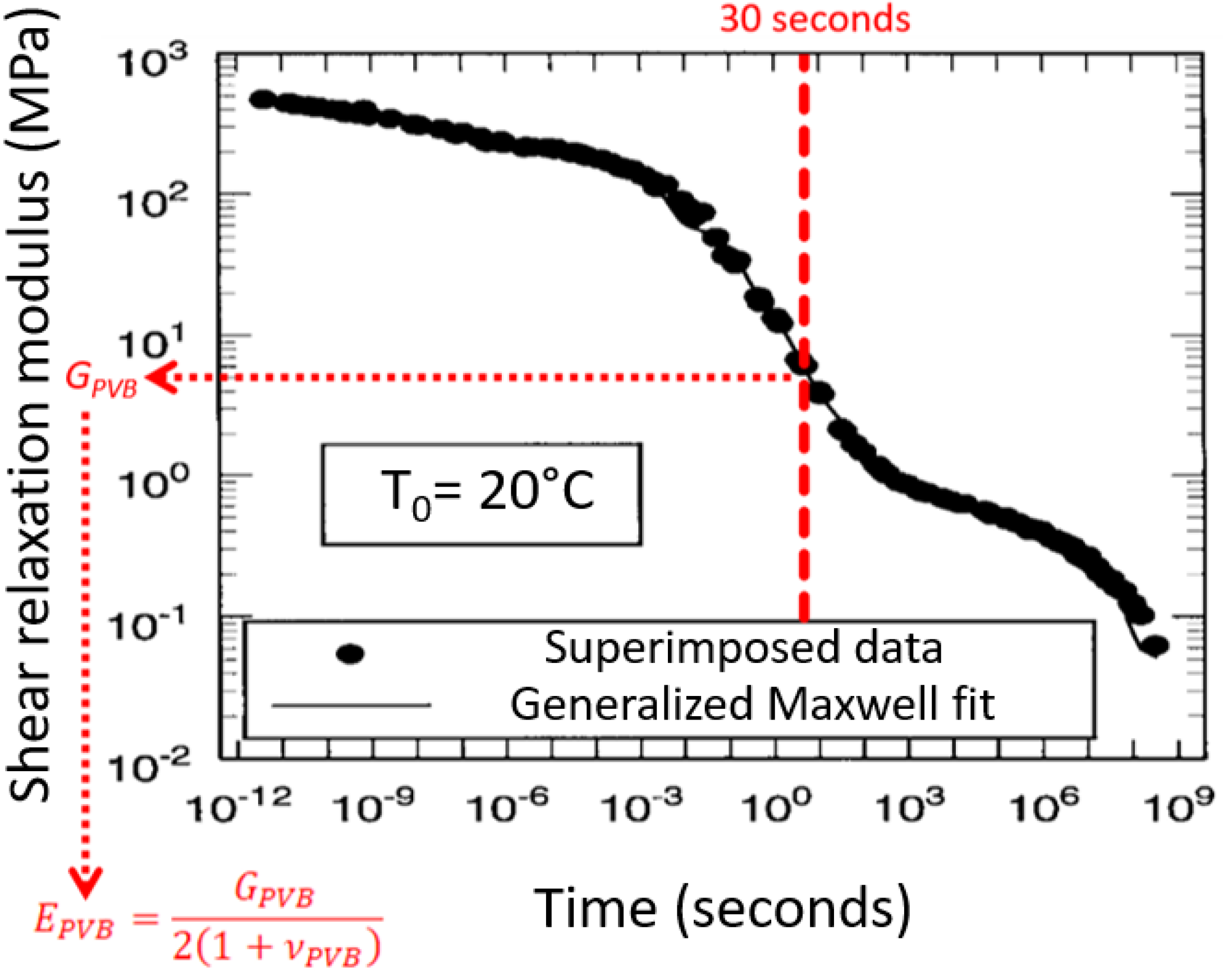

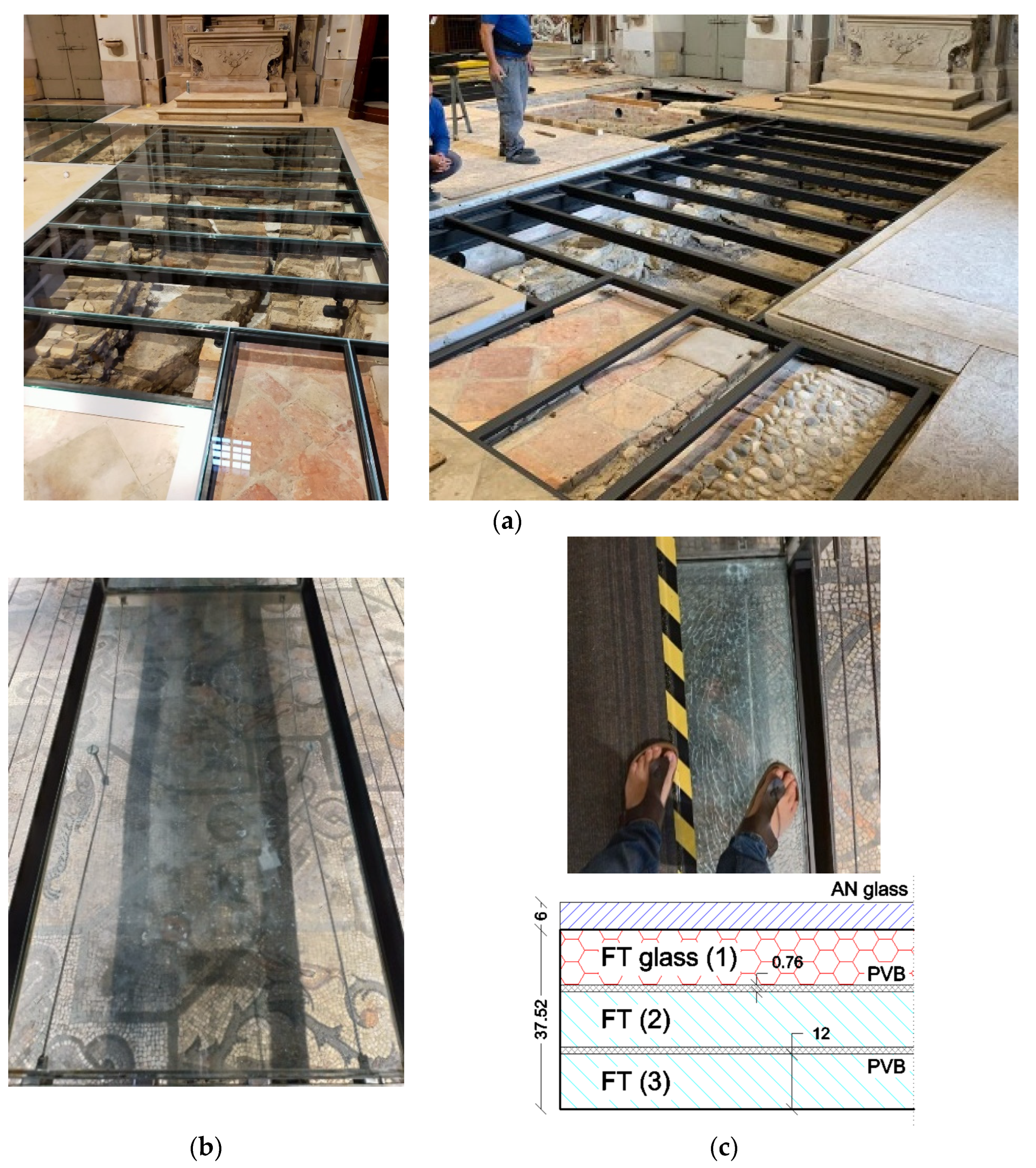

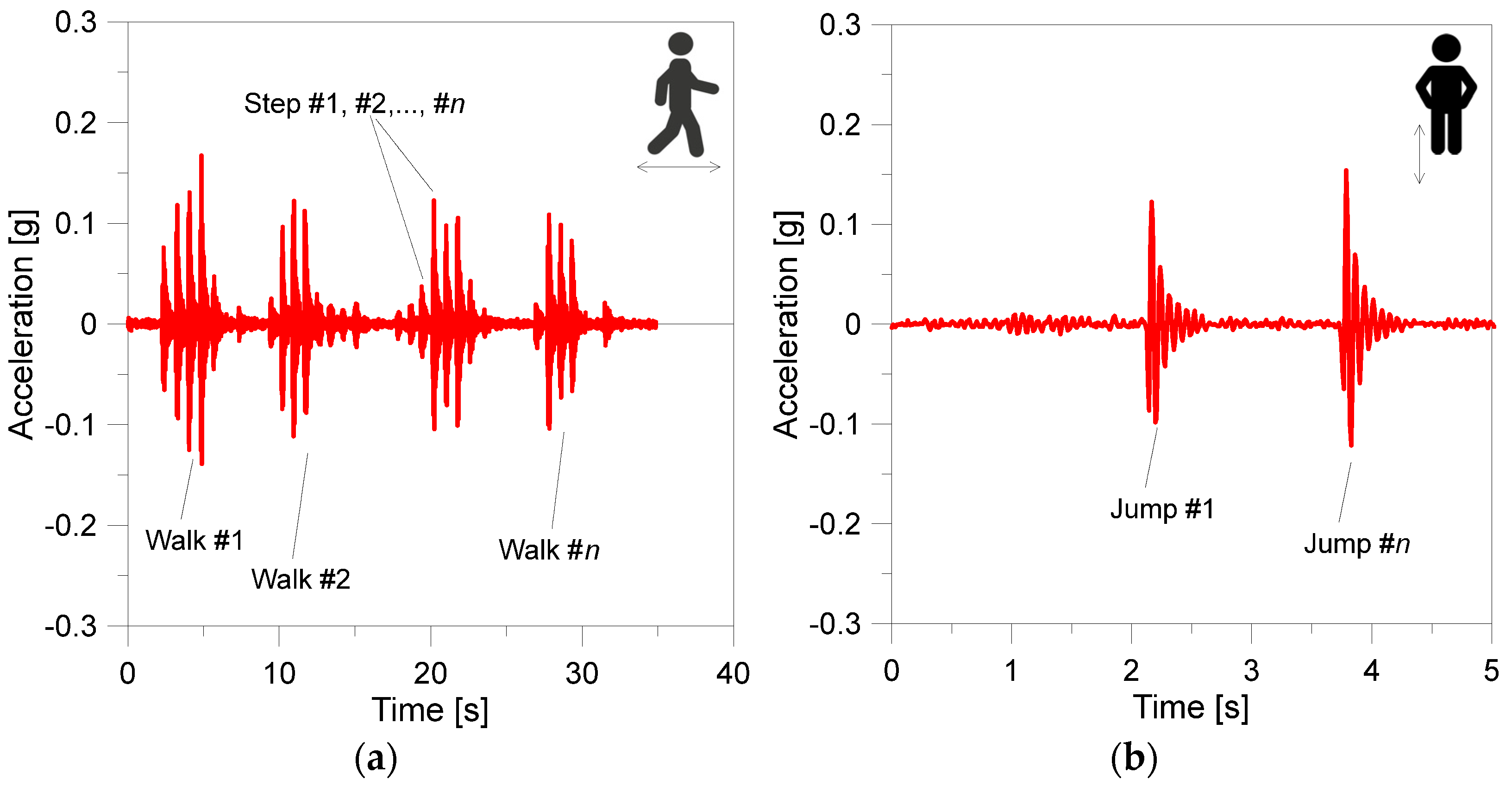
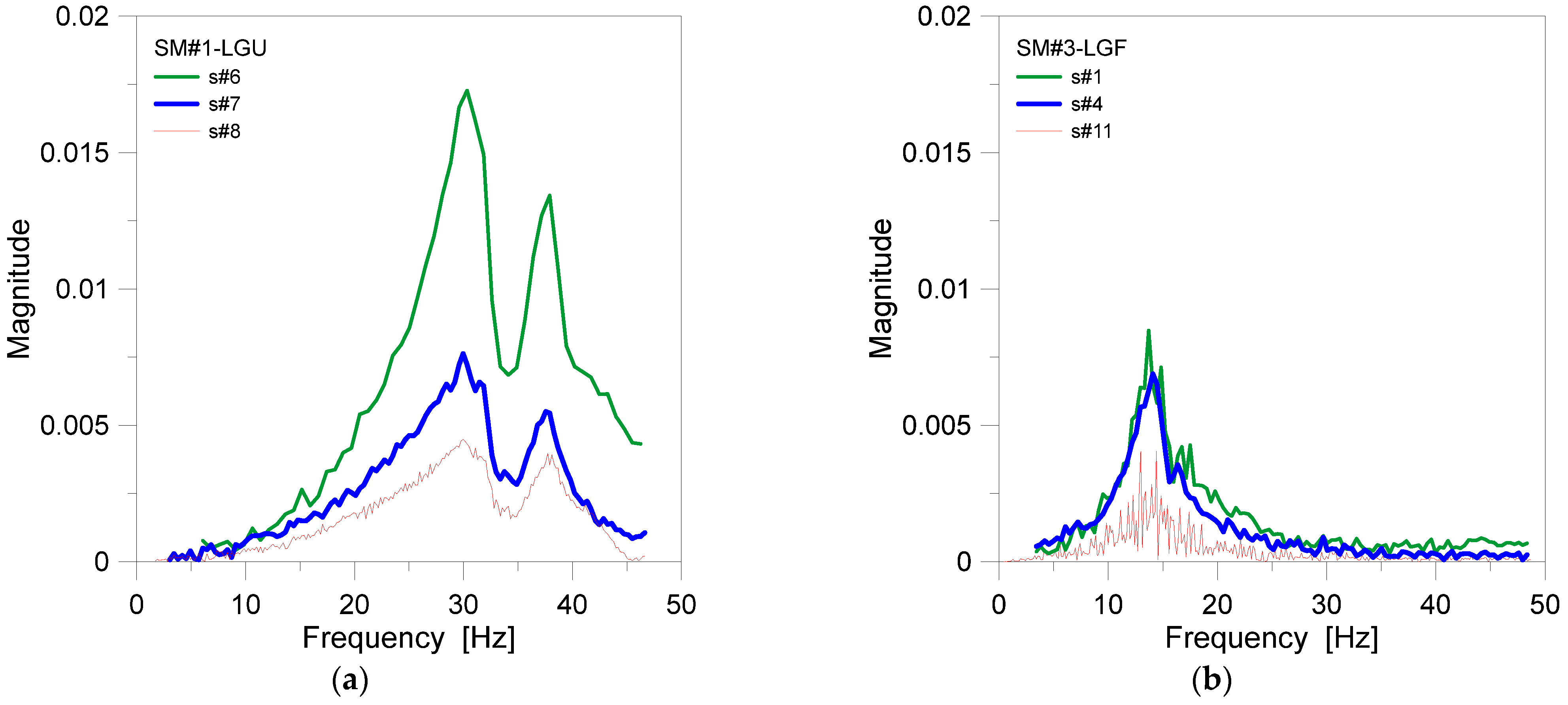
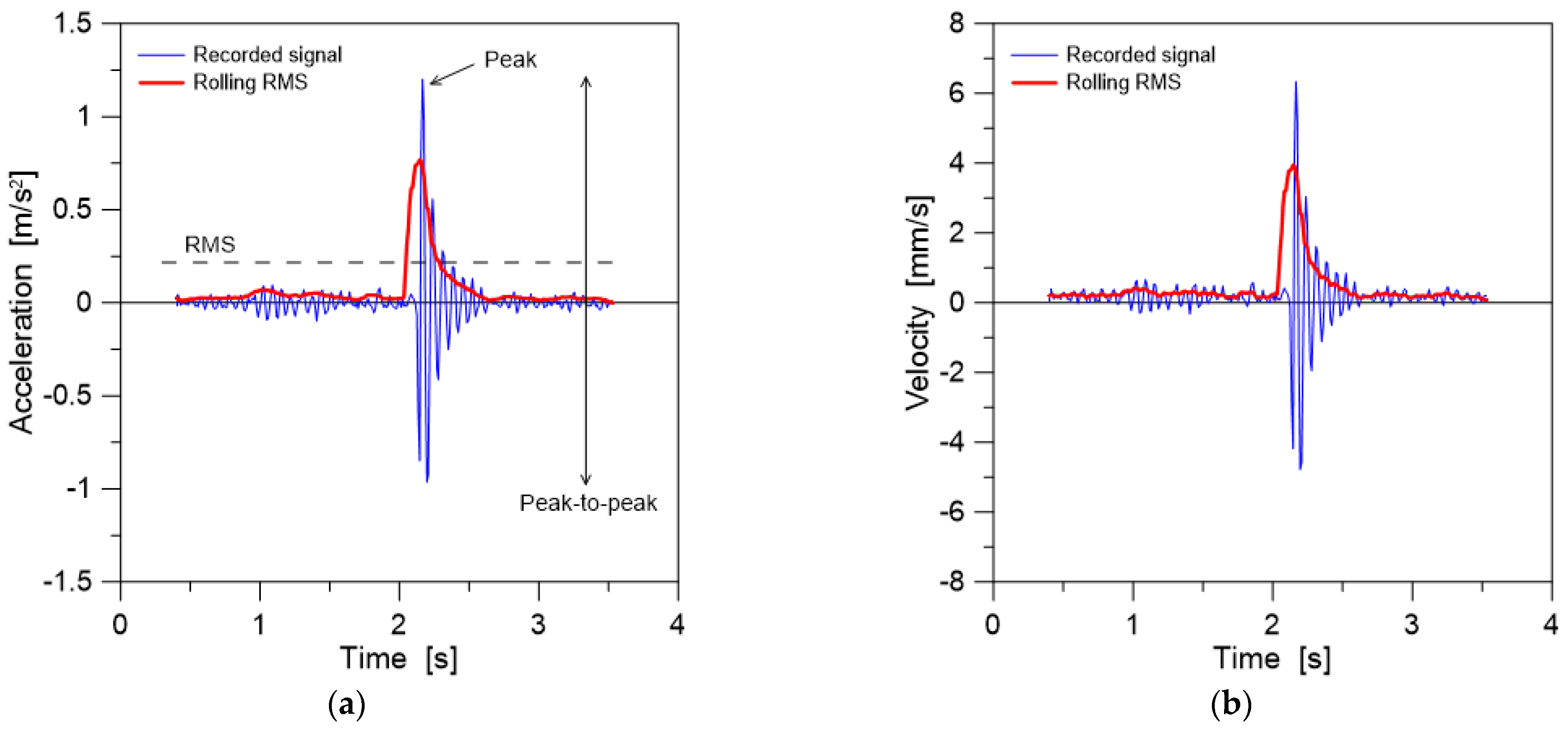
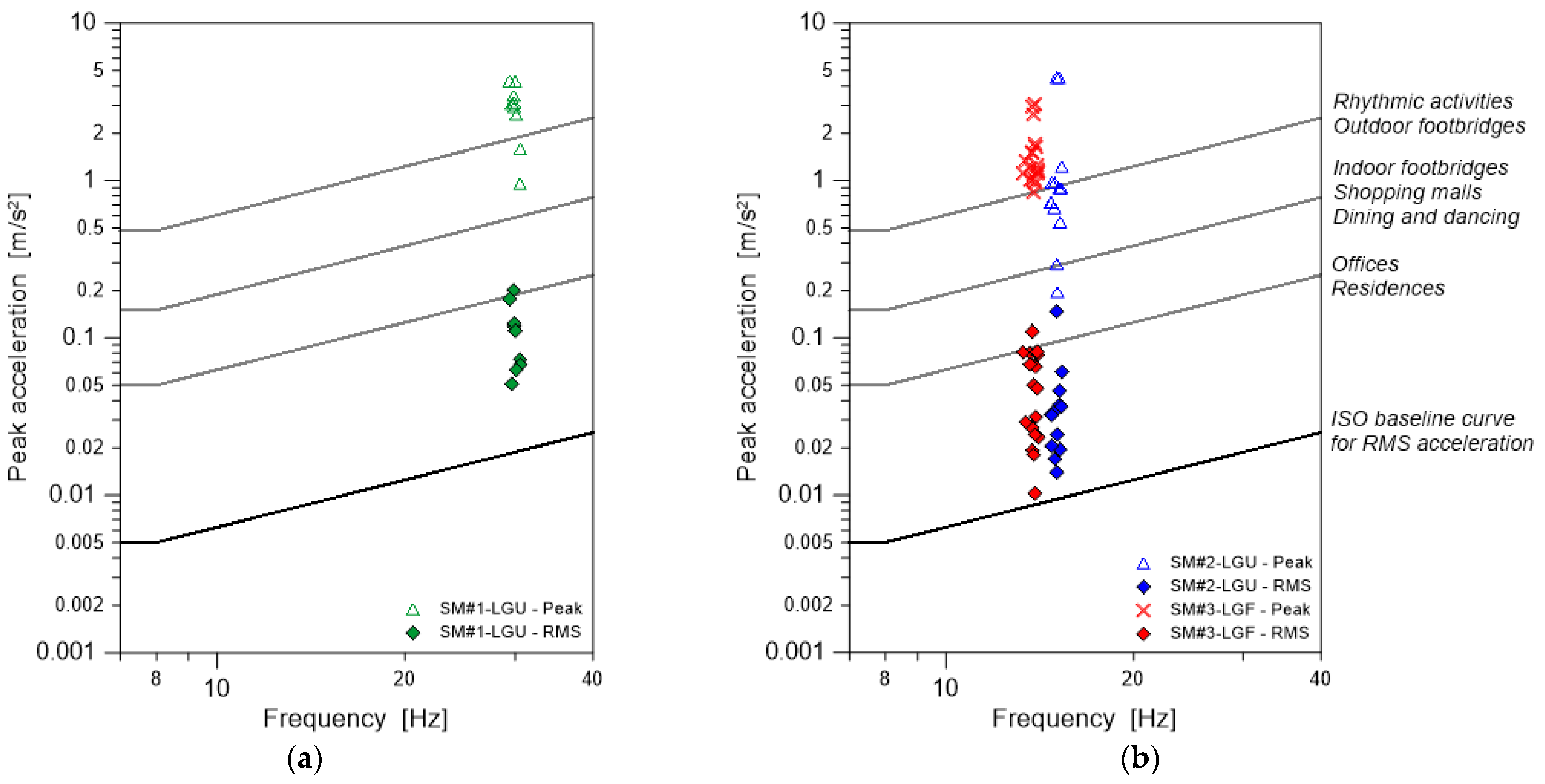
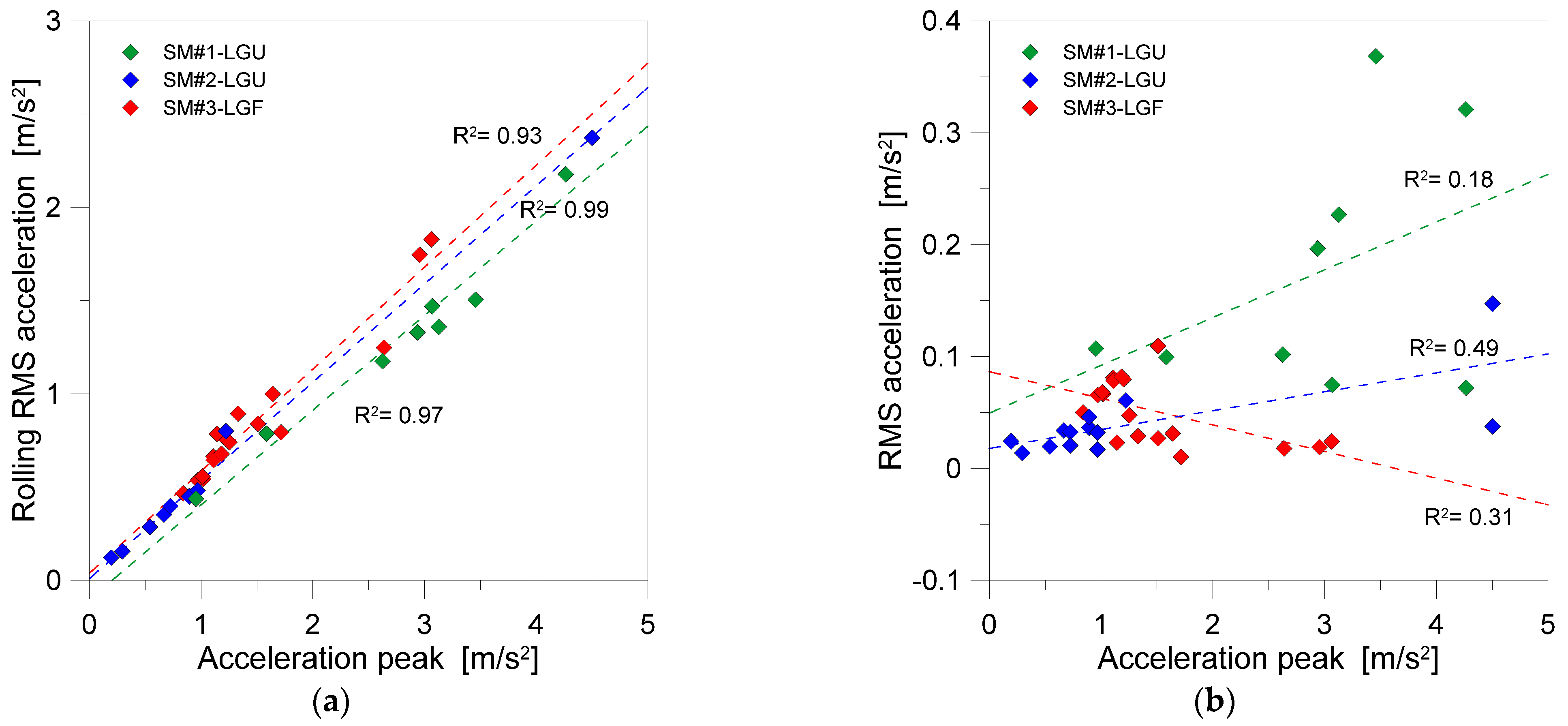
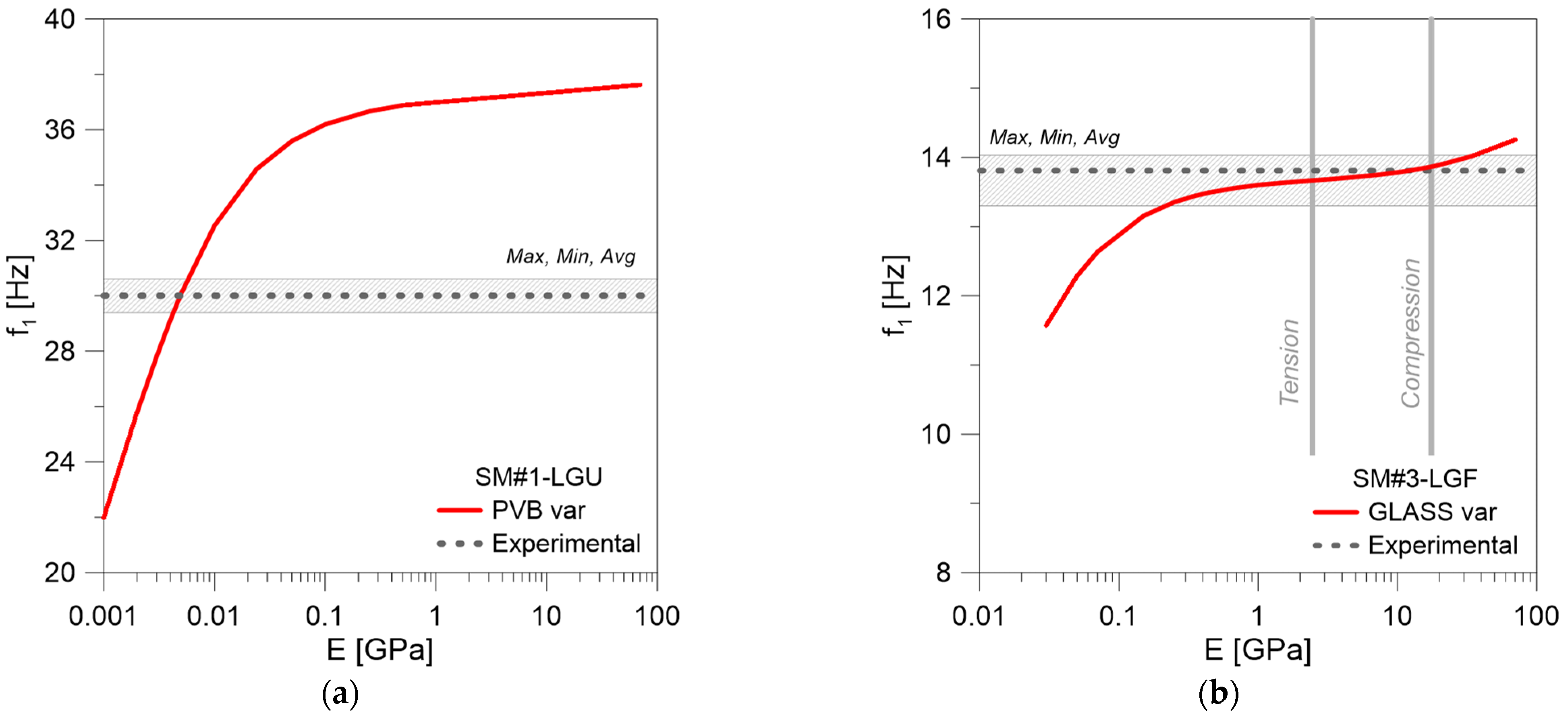
| Material | Elastic Modulus [MPa] | Poisson’ Ratio [-] | Density [kg/m3] | Behaviour |
|---|---|---|---|---|
| Glass | 70,000 | 0.23 | 2500 | Brittle elastic in tension |
| PVB (interlayer) | Variable * | 0.45 | 1000 | Viscoelastic |
| Mode Order n | ||
|---|---|---|
| 1 | 2 | 3 |
| π/Lef | 2π/Lef | 3π/Lef |
| Specimen | Dimensions [m] | Span [m] | Total Thickness [mm] | Cross-Section | Mass [kg] | RM Equation (4) | λ Equation (5) |
|---|---|---|---|---|---|---|---|
| SM#1–LGU | 0.51 × 2.80 | 0.51 | 27.52 | 8/10/8 + 0.76 PVB | 93 | 1.16 | 68 |
| SM#2–LGU | 1.35 × 2.65 | 2.65 | 37.52 + 6 | 12/12/12 + 0.76 PVB + AN cover | 320 | 4 | 245 |
| SM#3–LGF | 1.35 × 2.65 | 2.65 | 37.52 + 6 | 12/12/12 + 0.76 PVB + AN cover | 320 | 4 | 245 |
| Floor | Time | Recommended MF Limit | Experimentally Calculated MF (Average) from Equation (14) |
|---|---|---|---|
| Critical working area | Day & Night | 1 | 0.109 */0.02 ** = 5.47 for SM#1–LGU 0.040 */0.007 ** = 5.71 for SM#2–LGU 0.051 */0.006 ** = 8.50 for SM#3–LGF |
| Residential | Day | 2 to 4 | |
| Night | 1.4 | ||
| Quite office, Open plan | Day & Night | 2 | |
| General office | Day & Night | 4 | |
| Workshop | Day & Night | 8 |
| ULS Stress Ratio | SLS Deflection Ratio | |||||
|---|---|---|---|---|---|---|
| Sample | Time 0 | Current | SAFE (≤1) | Time 0 | Current | SAFE (≤1) |
| SM#1–LGU | 0.071 | 0.087 | Yes | 0.22 | 0.35 | Yes |
| SM#2–LGU | 0.29 | 0.34 | Yes | 0.31 | 0.45 | Yes |
| SM#3–LGF | 0.29 | 0.45 | Yes | 0.31 | 0.47 | Yes |
Disclaimer/Publisher’s Note: The statements, opinions and data contained in all publications are solely those of the individual author(s) and contributor(s) and not of MDPI and/or the editor(s). MDPI and/or the editor(s) disclaim responsibility for any injury to people or property resulting from any ideas, methods, instructions or products referred to in the content. |
© 2023 by the authors. Licensee MDPI, Basel, Switzerland. This article is an open access article distributed under the terms and conditions of the Creative Commons Attribution (CC BY) license (https://creativecommons.org/licenses/by/4.0/).
Share and Cite
Bedon, C.; Noè, S.; Fasan, M.; Amadio, C. Role of In-Field Experimental Diagnostic Analysis for the Derivation of Residual Capacity Indexes in Existing Pedestrian Glass Systems. Buildings 2023, 13, 754. https://doi.org/10.3390/buildings13030754
Bedon C, Noè S, Fasan M, Amadio C. Role of In-Field Experimental Diagnostic Analysis for the Derivation of Residual Capacity Indexes in Existing Pedestrian Glass Systems. Buildings. 2023; 13(3):754. https://doi.org/10.3390/buildings13030754
Chicago/Turabian StyleBedon, Chiara, Salvatore Noè, Marco Fasan, and Claudio Amadio. 2023. "Role of In-Field Experimental Diagnostic Analysis for the Derivation of Residual Capacity Indexes in Existing Pedestrian Glass Systems" Buildings 13, no. 3: 754. https://doi.org/10.3390/buildings13030754







